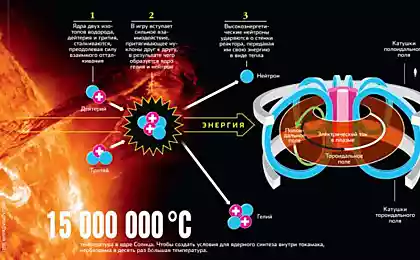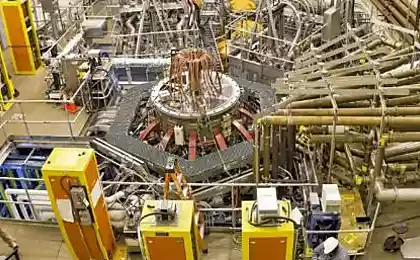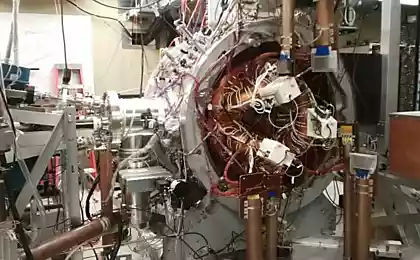1335
An important step on the way to laser fusion
On Wednesday, February 12, in the journal Nature published an article , describing the results of recent experiments on the National Ignition Facility (NIF) Lawrence Livermore National Laboratory, in which the first energy output as a result of the laser-induced controlled thermonuclear reaction exceeded the amount of energy transmitted by the fuel. Necessary to start nuclear fusion pressure and temperature achieved in the installation NIF using 192 lasers that simultaneously irradiated with a tiny target of frozen deuterium and tritium.

The target is a ball with a diameter of 2 mm, the outer layer is made of plastic, and internal - from the heavy isotope of hydrogen. Gold bead located inside a cylinder with holes, through which radiation enters into the laser. Under the influence of radiation inside the cylinder walls begin to emit X-rays, which are uniformly "fry" the target from all sides. Its outer shell is flashed and with great force compresses the fuel to a pressure of 100 million atmospheres. All this happens within a few nanoseconds. The peak power of the laser flash reaches 500 terawatt.
Until now it was not possible to obtain physicists from thermonuclear reactions more energy than the fuel passed, mainly due to the fact that during the compression of the fuel is mixed with the coating material. Since compression is not used for a laser pulse, and a few varying duration and power of individual bursts, you can manage this process. In recent experiments, conducted in the fall of 2013, managed to pick up a sequence of pulses, which provides a stable grip and reduces contamination of the fuel atoms shell. September 27, 2013 managed to get 14 kilojoules of energy spent for compression and heating fuel about 12 kJ. November 13 - 17 kJ at a cost of 10 kJ. In early 2014, the ratio of produced energy to fuel consumed managed to bring up to 2, 6.

Although these results - an important milestone on the path to fusion energy to practical use yet very far. The fact that the overall cost of installing power per pulse is two orders more than the amount of energy that reaches the capsule with fuel. More economic efficiency is much lower - about self-sustaining reaction synthesis while we are not talking, NIF - purely experimental setup, it can do no more than one "shot" in a few hours.
Project Международного experimental nuclear reactor (ITER) , the construction of which now goes to France, still looks more practical - the beginning of the experiments it is planned for 2020, and developing fusion power should reach 500 megawatts. Reactor ITER is a huge tokamak - thermonuclear reaction in it takes place in the toroidal chamber inside the plasma" cord ", held by the magnetic field. Everything in the world was built around 300 tokamak experiments conducted with them for several decades. Position pulse type, which include NIF, are much less common.
Source: habrahabr.ru/post/212489/

The target is a ball with a diameter of 2 mm, the outer layer is made of plastic, and internal - from the heavy isotope of hydrogen. Gold bead located inside a cylinder with holes, through which radiation enters into the laser. Under the influence of radiation inside the cylinder walls begin to emit X-rays, which are uniformly "fry" the target from all sides. Its outer shell is flashed and with great force compresses the fuel to a pressure of 100 million atmospheres. All this happens within a few nanoseconds. The peak power of the laser flash reaches 500 terawatt.
Until now it was not possible to obtain physicists from thermonuclear reactions more energy than the fuel passed, mainly due to the fact that during the compression of the fuel is mixed with the coating material. Since compression is not used for a laser pulse, and a few varying duration and power of individual bursts, you can manage this process. In recent experiments, conducted in the fall of 2013, managed to pick up a sequence of pulses, which provides a stable grip and reduces contamination of the fuel atoms shell. September 27, 2013 managed to get 14 kilojoules of energy spent for compression and heating fuel about 12 kJ. November 13 - 17 kJ at a cost of 10 kJ. In early 2014, the ratio of produced energy to fuel consumed managed to bring up to 2, 6.

Although these results - an important milestone on the path to fusion energy to practical use yet very far. The fact that the overall cost of installing power per pulse is two orders more than the amount of energy that reaches the capsule with fuel. More economic efficiency is much lower - about self-sustaining reaction synthesis while we are not talking, NIF - purely experimental setup, it can do no more than one "shot" in a few hours.
Project Международного experimental nuclear reactor (ITER) , the construction of which now goes to France, still looks more practical - the beginning of the experiments it is planned for 2020, and developing fusion power should reach 500 megawatts. Reactor ITER is a huge tokamak - thermonuclear reaction in it takes place in the toroidal chamber inside the plasma" cord ", held by the magnetic field. Everything in the world was built around 300 tokamak experiments conducted with them for several decades. Position pulse type, which include NIF, are much less common.
Source: habrahabr.ru/post/212489/
Facebook is testing the water taxi to transport employees from San Francisco
The UAE has started the project of using unmanned vehicles for the delivery of essential goods





















